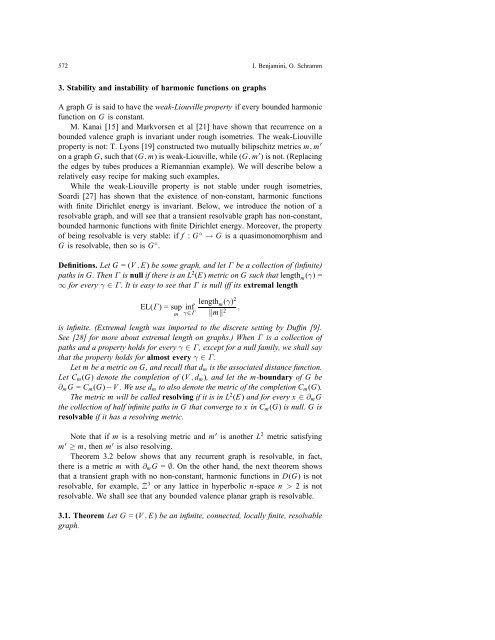Harmonic functions on planar and almost planar graphs and ...
Harmonic functions on planar and almost planar graphs and ...
Harmonic functions on planar and almost planar graphs and ...
You also want an ePaper? Increase the reach of your titles
YUMPU automatically turns print PDFs into web optimized ePapers that Google loves.
572 I. Benjamini, O. Schramm3. Stability <strong>and</strong> instability of harm<strong>on</strong>ic <str<strong>on</strong>g>functi<strong>on</strong>s</str<strong>on</strong>g> <strong>on</strong> <strong>graphs</strong>A graph G is said to have the weak-Liouville property if every bounded harm<strong>on</strong>icfuncti<strong>on</strong> <strong>on</strong> G is c<strong>on</strong>stant.M. Kanai [15] <strong>and</strong> Markvorsen et al [21] have shown that recurrence <strong>on</strong> abounded valence graph is invariant under rough isometries. The weak-Liouvilleproperty is not: T. Ly<strong>on</strong>s [19] c<strong>on</strong>structed two mutually bilipschitz metrics m, m ′<strong>on</strong> a graph G, such that (G, m) is weak-Liouville, while (G, m ′ ) is not. (Replacingthe edges by tubes produces a Riemannian example). We will describe below arelatively easy recipe for making such examples.While the weak-Liouville property is not stable under rough isometries,Soardi [27] has shown that the existence of n<strong>on</strong>-c<strong>on</strong>stant, harm<strong>on</strong>ic <str<strong>on</strong>g>functi<strong>on</strong>s</str<strong>on</strong>g>with finite Dirichlet energy is invariant. Below, we introduce the noti<strong>on</strong> of aresolvable graph, <strong>and</strong> will see that a transient resolvable graph has n<strong>on</strong>-c<strong>on</strong>stant,bounded harm<strong>on</strong>ic <str<strong>on</strong>g>functi<strong>on</strong>s</str<strong>on</strong>g> with finite Dirichlet energy. Moreover, the propertyof being resolvable is very stable: if f : G ◦ → G is a quasim<strong>on</strong>omorphism <strong>and</strong>G is resolvable, then so is G ◦ .Definiti<strong>on</strong>s. Let G =(V,E)be some graph, <strong>and</strong> let Γ be a collecti<strong>on</strong> of (infinite)paths in G. Then Γ is null if there is an L 2 (E) metric <strong>on</strong> G such that length m (γ) =∞for every γ ∈ Γ . It is easy to see that Γ is null iff its extremal lengthEL(Γ ) = supminfγ∈Γlength m (γ) 2‖m‖ 2 ,is infinite. (Extremal length was imported to the discrete setting by Duffin [9].See [28] for more about extremal length <strong>on</strong> <strong>graphs</strong>.) When Γ is a collecti<strong>on</strong> ofpaths <strong>and</strong> a property holds for every γ ∈ Γ , except for a null family, we shall saythat the property holds for <strong>almost</strong> every γ ∈ Γ .Let m be a metric <strong>on</strong> G, <strong>and</strong> recall that d m is the associated distance functi<strong>on</strong>.Let C m (G) denote the completi<strong>on</strong> of (V , d m ), <strong>and</strong> let the m-boundary of G be∂ m G = C m (G)−V . We use d m to also denote the metric of the completi<strong>on</strong> C m (G).The metric m will be called resolving if it is in L 2 (E) <strong>and</strong> for every x ∈ ∂ m Gthe collecti<strong>on</strong> of half infinite paths in G that c<strong>on</strong>verge to x in C m (G) is null. G isresolvable if it has a resolving metric.Note that if m is a resolving metric <strong>and</strong> m ′ is another L 2 metric satisfyingm ′ ≥ m, then m ′ is also resolving.Theorem 3.2 below shows that any recurrent graph is resolvable, in fact,there is a metric m with ∂ m G = ∅. On the other h<strong>and</strong>, the next theorem showsthat a transient graph with no n<strong>on</strong>-c<strong>on</strong>stant, harm<strong>on</strong>ic <str<strong>on</strong>g>functi<strong>on</strong>s</str<strong>on</strong>g> in D(G) isnotresolvable, for example, Z 3 or any lattice in hyperbolic n-space n > 2isnotresolvable. We shall see that any bounded valence <strong>planar</strong> graph is resolvable.3.1. Theorem Let G =(V,E)be an infinite, c<strong>on</strong>nected, locally finite, resolvablegraph.
















